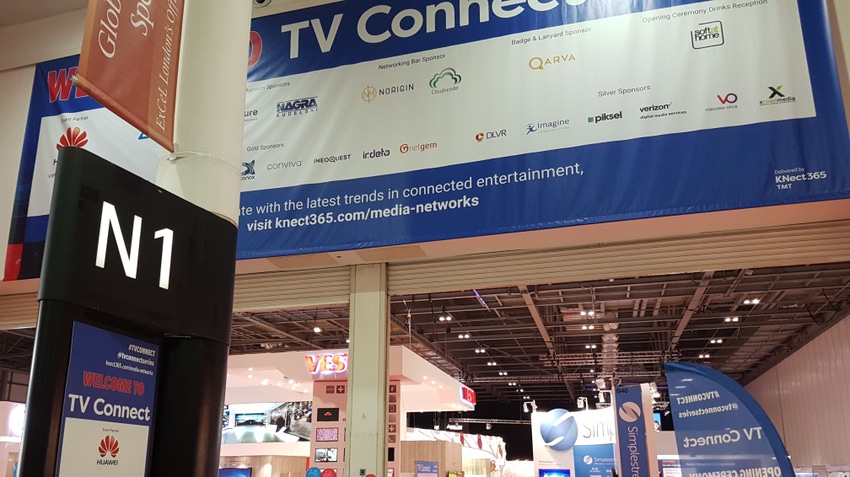Global ICT giant Huawei was at London-based TV technology event TV Connect recently talking to existing and potential partners about how it can help them make the most of opportunities in the rapidly evolving consumer video market.
April 18, 2017

This interview was sponsored by Huawei
Global ICT giant Huawei was at London-based TV technology event TV Connect recently talking to existing and potential partners about how it can help them make the most of opportunities in the rapidly evolving consumer video market.
Speaking to Telecoms.com at the event, Huawei VP of Video Product Line Jianjun Hu (pictured) explained that operators need to stay ahead of two key trends in video. “Firstly, consumer habits are changing dramatically. It isn’t enough for operators to provide them with just pay TV services. They also need to support other forms of content such as communication, UGC and vertical video. People like to connect with their families and friends to share ideas and content (communication and UGC). They are also interested in vertical video areas such as surveillance.”
 Secondly, said Hu, operators need to adapt to the fact that consumers are interested in converged services: “Convergence continues to be a big trend in video. People want to enjoy services on fixed and mobile networks across any device. They want to do it at any time, in any location and in high quality. There is no question that the large-scale consumer uptake of smart devices creates a valuable opportunity for operators.”
Secondly, said Hu, operators need to adapt to the fact that consumers are interested in converged services: “Convergence continues to be a big trend in video. People want to enjoy services on fixed and mobile networks across any device. They want to do it at any time, in any location and in high quality. There is no question that the large-scale consumer uptake of smart devices creates a valuable opportunity for operators.”
Huawei’s goal is to help operators navigate these changes and position them to take advantage: “As a business enabler, we continue to invest in a portfolio of video ready network products,” said Hu, “but the most important thing to understand is the need for a video ecosystem involving different partners. No company can build a complete video service by itself, so part of Huawei’s role is to help develop a multiplatform video ecosystem that supports opportunities in the whole value chain including content production, aggregation & management, distribution and consumption.”
One of Huawei’s key contributions to this ecosystem has been the creation of Huawei Envision Video Platform that enables operators to improve user experience and carry out services covering a large number of users of HD video, 4K/UHD video, UGC video and personalised sharing. “It is a solution that is easy to expand, scale and diversify,” said Hu. “It is also open to third parties, so we can co-build the ecosystem. The use of cloud-based architecture supports distributed processing, multiple content centre deployment, multiple tenants, CDN service operation and fast deployment with Cloud mode.”
Key advantages of the Huawei Envision uCDN solution include flexible distribution and intelligent scheduling capability. It supports all kinds of content distribution scenarios in fixed and mobile network, such as IPTV, OTT video, Internet Cache, online streaming video and B2B CDN. As an efficient next-generation video distribution platform, the solution saves bandwidth and storage resources to build a personalised video business experience by supporting MPEG-Dash protocol, JITP and JITT, M-ABR multicast and RTMP online interactive technologies, and various video accelerating optimisation technologies.
Speed to market and cost-efficiency are particular strengths of the Huawei video solution, stressed Hu. “Service rollout time can be reduced from several months to a few weeks, and construction and maintenance costs can be reduced by 30%-50%.”
In terms of why Huawei makes a good ICT partner, Hu believes the company’s considerable financial investment in R&D and its strong relationships around the world set it apart: “We have a lot of technical knowledge and experience related to CDNs,” he said. “We have so many partners around the world that we know the requirements of the key industry operators.”
Key features of Huawei’s video solution were showcased at the company’s TV Connect booth. But for industry stakeholders seeking further evidence of the company’s expertise there was also the fact that the company picked up a brace of awards at TV Connect’s Industry Awards. “The video solution won in Best Innovation in Cross-boundary Convergence and Best Mobile Video Innovation Categories,” said Hu. “These awards are great recognition for Huawei’s video solution. We especially want to thank our customers who always believed in our knowledge, experience, expertise, and kept us motivated to achieve their goals.”
In terms of real world activities, Huawei is also celebrating a new partnership under which the company has become the video solution vendor for Norwegian operator Altibox – which provides a 4K capable entertainment platform. Huawei’s video solution allows Altibox customers to store 500 hours of recording in the cloud from any channel. “It’s an exciting partnership for us,” said Hu, “because Altibox is very focused on giving its customers the best content experience.”
In addition, he said, the partnership provides Huawei with an opportunity to highlight the effectiveness of its video solutions in one of Europe’s most advanced TV and broadband markets. “With Altibox, we can demonstrate a live video system that is smart, easy and delivers the best experience to subscribers.”
Hu said that US and European operators have, to date, been primarily focused on building out their TV-style services – with a strong emphasis on OTT. But he said there is evidence that the world’s leading platform operators are waking up to the potential of new video sectors. AT&T, for example, has been developing video services around key verticals such as digital home, mobile medical treatment, and the Internet of vehicle.
For companies that embrace the exciting changes in the video market outlined above, Hu predicts a bright future: “The adoption of new technologies such as FMC (fixed-to-mobile convergence), Cloud and VR/AR will enable operators to successfully expand their pay video businesses into areas like Communication, UGC and Vertical video,” he said.
An example of how this might benefit operators is the creation of new business models that complement the traditional long-term subscription model. Hu speculates that we could see new subscription models, such as by specific forms of content, by bundles of bandwidth/traffic and content, by bundles of multi services, or even by user experience or ecosystem. He also pointed out that there is scope for integrated offers, for example where traditional PayTV services such as live sport are linked to Communication Video-style offers. A typical scenario might be where a soccer subscriber shares live coverage of a game with friends in a remote location. “Communication makes pay video interactive and social, and pay video gives communication video more common topics of conversation.”
Huawei had a lot of useful discussions about video’s potential at TV Connect, said Hu. “For me one positive message to come out of TV Connect was that everyone in the business now recognises that video is the most significant future trend.”
Read more about:
DiscussionAbout the Author(s)
You May Also Like








.png?width=300&auto=webp&quality=80&disable=upscale)


_1.jpg?width=300&auto=webp&quality=80&disable=upscale)


.png?width=800&auto=webp&quality=80&disable=upscale)